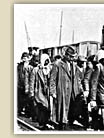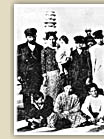|
|
 |
 |
 |
 |
 |
 |
 |
 |
 |
 |
|
In the first decades of the twentieth century the geographical framework of the whole
Balkan peninsula was transformed and new developments affected, directly or indirectly, the life of its
inhabitants.
|

Military confrontations resulted in
waves of refugees, deportations, settlements and resettlements: large
population groups were put into motion. In the period following the Balkan Wars and later, in the course
of the First World War, clashes and the intense hostility between the Balkan states
brought the problems inherent in the presence of populations of different nationality. Large population groups followed the retreat or advance of troops.
At the same time, the Balkan governments exploited the presence
of foreign populations in their national territory in order to exert pressure on their
opponents.
These conditions led to the arrival in Greece of a large number
of Greek refugees originating from various Balkan countries. These
refugees came from Bulgaria, Western Thrace (under Bulrgarian control
at the time) and areas of Macedonia beyond the Greek frontiers.
They also originated from Asia Minor and Eastern Thrace, where the
Young Turks had inaugurated the systematic persecution of Greeks
with the result that many of them fled to Greece, whereas others
were deported to the interior of Asia Minor.
The annexation of the largest part of Macedonia to Greece beyond its essential economic and political implications
meant the integration of new landless farmers, frequently of different
national-cultural origins, in the productive potential of the country. Thus, in
the 1910s, a large number of Bulgarian and Turkish Muslims residing in the
New Territories departed for Bulgaria and Turkey.
|
 |

It must also be added that during the course of the First World War,
part of Macedonia became a battlefield, a fact that contributed
to the movement of populations.
Also, in 1919 refugees reached Greece from the Soviet Pontus, in an
organized expedition undertaken by the Greek state for their evacuation
and transfer to Greece. Most of them settled in the territories of
Macedonia.
Towards the end of 1914 there were 150,000 refugees in Macedonia
while the number in southern Greece has not been defined. The total number
of refugees asking for the aid of relief services reached that period
117,484. Some effort was made to provide them relief, not an easy task
under the prevailing conditions.
In the field of housing results were poor due to the lack
of materials and resources. The government tried to resettle them on public agricultural lands, because large estate owners would not hire them as
farm labourers. Their absorption as industrial workers in the cities
was equally difficult. Until 1915 the overall expenses of the state regarding the
resettlement of refugees reached 15,817,640 drachmas. An inability
to support them was one of the factors that had contributed to the decision for
agricultural reforms in 1917.
After the end of the First World War a large proportion of the Greek refugees
of that period returned to their places of origin.
Those originating from western Thrace settled permanently in their homelands, while
many Asia Minor inhabitants and the inhabitants of eastern Thrace
returned to their homeland during the Greek occupation,
until the Catastrophe of 1922 and the exchange of populations.
|
 |
 |
|
